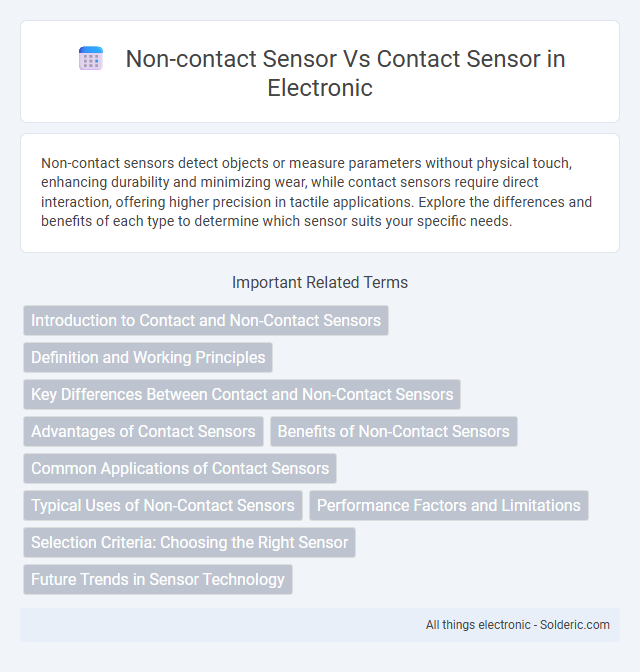Non-contact sensors detect objects or measure parameters without physical touch, enhancing durability and minimizing wear, while contact sensors require direct interaction, offering higher precision in tactile applications. Explore the differences and benefits of each type to determine which sensor suits your specific needs.
Comparison Table
| Feature | Non-Contact Sensor | Contact Sensor |
|---|---|---|
| Working Principle | Detects objects without physical touch using electromagnetic, optical, or ultrasonic signals | Requires physical contact to detect presence, position, or physical parameters |
| Examples | Infrared sensors, Ultrasonic sensors, Capacitive proximity sensors | Limit switches, tactile sensors, strain gauges |
| Durability | High, no wear due to lack of contact | Lower, prone to mechanical wear and tear |
| Sensitivity | Varies; can detect presence, distance, or material properties remotely | Direct measurement, generally higher accuracy in physical parameter detection |
| Applications | Object detection, distance measurement, safety, automated systems | Position detection, force measurement, user interface, safety interlocks |
| Installation Complexity | Typically easier due to absence of mechanical parts | May require mounting in contact points, more maintenance |
| Cost | Generally higher initial cost for advanced technology | Usually lower cost with simpler technology |
Introduction to Contact and Non-Contact Sensors
Contact sensors directly interact with the object's surface to measure physical properties such as pressure, temperature, or displacement, providing precise and reliable data in environments where direct touch is feasible. Non-contact sensors utilize technologies like infrared, ultrasonic, or laser to detect and measure without physical contact, enabling use in hazardous or delicate situations where interference must be minimized. Both sensor types are critical in industrial automation, robotics, and medical applications, with the choice depending on factors like measurement accuracy, environment, and object properties.
Definition and Working Principles
Non-contact sensors detect physical properties or changes without direct physical contact, using methods like optical, ultrasonic, or electromagnetic fields to sense objects or measure parameters. Contact sensors require direct interaction with the target surface to measure variables such as temperature, pressure, or displacement through physical contact points. The working principle of non-contact sensors relies on detecting emitted or reflected signals, while contact sensors operate by converting physical force or changes at the interface into readable electrical signals.
Key Differences Between Contact and Non-Contact Sensors
Non-contact sensors detect objects or changes without physical contact by using methods such as optical, ultrasonic, or electromagnetic signals, while contact sensors require direct physical interaction with the target to measure parameters like pressure, force, or temperature. Non-contact sensors offer advantages in environments where contamination, wear, or safety are concerns, providing faster response times and longer lifespans. Your choice between these sensors depends on application requirements such as accuracy, environmental conditions, and the nature of the measured object.
Advantages of Contact Sensors
Contact sensors offer precise and reliable measurements by maintaining direct physical interaction with the target, ensuring high accuracy for applications requiring exact data. Their performance is less affected by environmental factors such as dust, moisture, or ambient light, making them ideal for harsh industrial settings. You benefit from consistent, stable output signals, which are essential for critical processes and safety systems.
Benefits of Non-Contact Sensors
Non-contact sensors offer significant benefits including enhanced durability since they avoid physical wear and tear, leading to longer operational lifespans in industrial environments. These sensors provide improved safety by eliminating the need for direct interaction with hazardous materials or moving parts, reducing the risk of accidents. Additionally, non-contact sensors enable precise measurements without affecting the target object, ensuring high accuracy in applications such as temperature monitoring, proximity detection, and displacement measurement.
Common Applications of Contact Sensors
Contact sensors are widely used in security systems for door and window monitoring, ensuring physical interaction triggers alerts. Industrial automation often relies on contact sensors to detect position, limit, and presence for machinery safety and operational efficiency. Your manufacturing processes benefit from these sensors by providing precise and reliable feedback for equipment control and safety compliance.
Typical Uses of Non-Contact Sensors
Non-contact sensors are widely used in industrial automation for detecting objects without physical interaction, enhancing durability and reducing wear. These sensors are essential in applications like conveyor belt monitoring, robotic arm positioning, and hazardous environment sensing where direct contact is unsafe or impractical. Your systems benefit from increased reliability and maintenance savings by integrating non-contact sensors in areas requiring precise, continuous measurement without mechanical interference.
Performance Factors and Limitations
Non-contact sensors offer high precision and durability by avoiding physical wear and friction, making them ideal for high-speed or harsh environments, but they may face challenges with surface reflectivity and environmental interference. Contact sensors typically provide reliable measurements through direct physical interaction, yet they can suffer from mechanical wear, slower response times, and potential surface damage. Your choice depends on balancing factors such as measurement accuracy, environmental conditions, and maintenance requirements.
Selection Criteria: Choosing the Right Sensor
Non-contact sensors offer advantages in applications requiring wear-free operation, high-speed detection, and measurement of moving or fragile objects, making them ideal for environments with contamination or high temperatures. Contact sensors provide precise position or pressure feedback when physical interaction is necessary, often preferred for tasks needing direct tactile response or mechanical actuation. Your selection between non-contact and contact sensors should consider factors like accuracy requirements, environmental conditions, maintenance needs, and the nature of the target object.
Future Trends in Sensor Technology
Future trends in sensor technology emphasize the rise of non-contact sensors due to their ability to measure parameters without physical interaction, reducing wear and contamination risks. Advances in lidar, optical, and ultrasonic sensors are driving improvements in accuracy, range, and integration with IoT devices. Contact sensors remain relevant for applications requiring direct measurement, but the shift toward non-contact solutions is propelled by demand for faster, safer, and more versatile sensing in automotive, healthcare, and industrial automation.
non-contact sensor vs contact sensor Infographic

 solderic.com
solderic.com